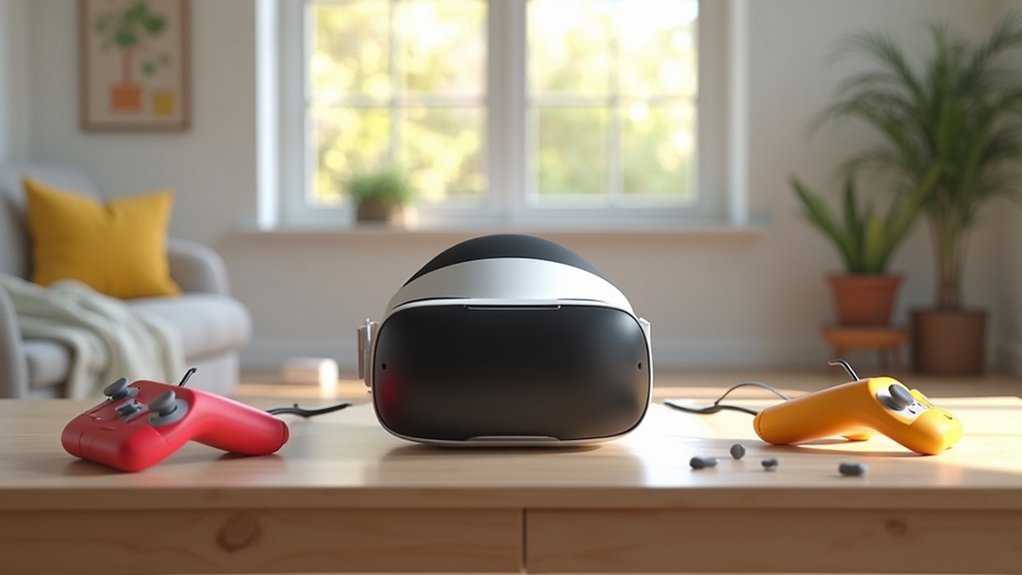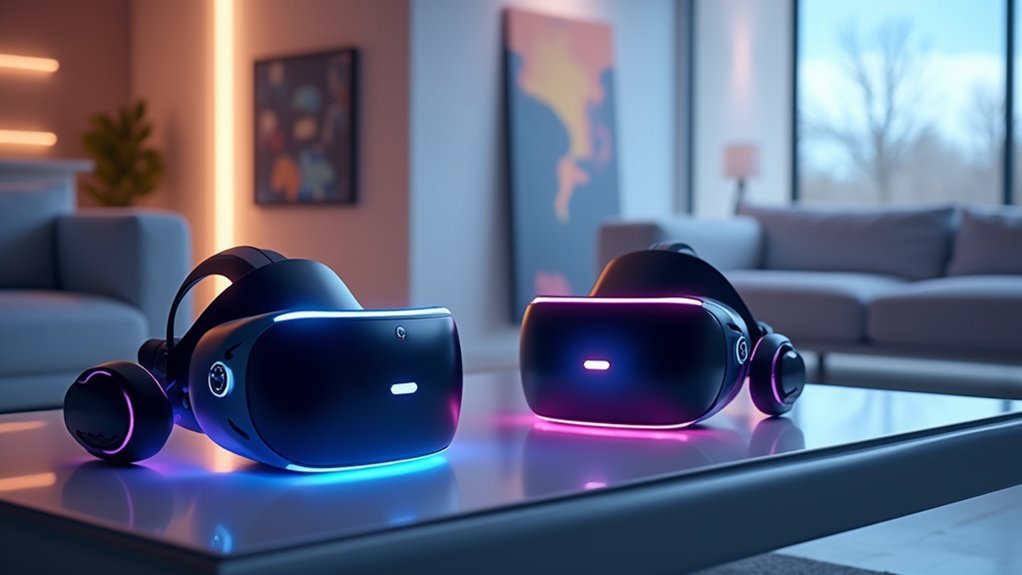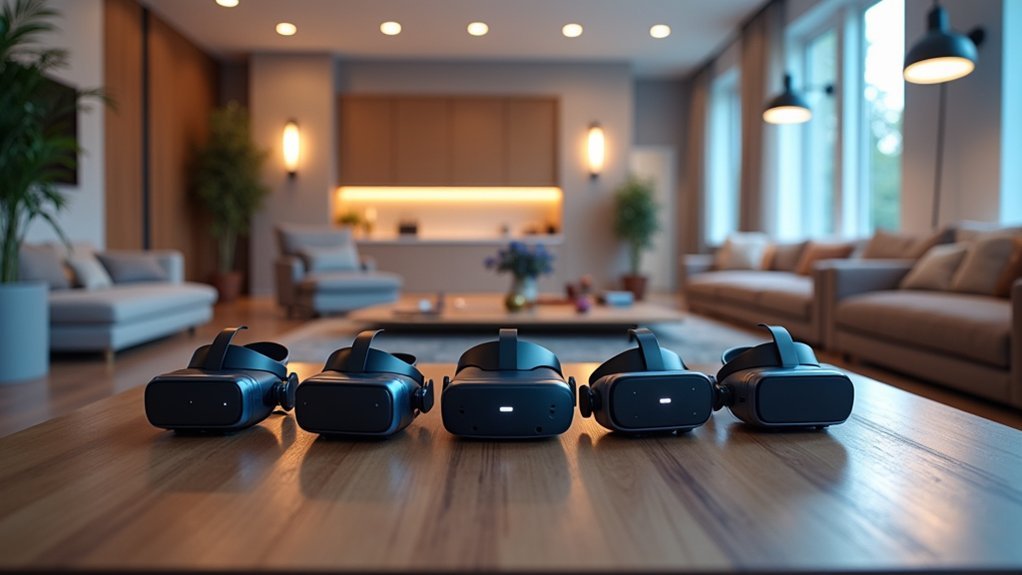The top untethered VR headsets for roomscale include Meta Quest 3 with its 4K+ display and powerful Snapdragon XR2 Gen 2 processor, HTC Vive Focus 3 featuring 120° FOV and hot-swappable batteries, and Pico 4 offering high-resolution displays at a budget price. Look for systems with precise tracking accuracy, comfortable designs for extended sessions, and future-proof features like mixed reality capabilities. The differences in tracking technology will greatly impact your immersive experience.
Meta Quest 3: The Ultimate Untethered VR Experience

The Meta Quest 3 stands as a technological marvel in the untethered VR landscape. With the Snapdragon XR2 Gen 2 processor, this standalone headset delivers doubled graphics performance without requiring a PC connection.
You’ll experience stunning visuals through its 4K+ Infinite Display, offering 2064 x 2208 pixels per eye—nearly 30% sharper than Quest 2. The impressive 110° horizontal and 96° vertical FOV creates truly immersive environments.
What sets Quest 3 apart is its high-fidelity color passthrough, seamlessly blending virtual and physical worlds for mixed reality experiences. The 40% slimmer design enhances comfort during your 2-3 hour play sessions. As an added bonus, your purchase includes the popular Batman: Arkham Shadow game while supplies last.
Priced at $499 (128GB) or $649 (512GB), it’s positioned as a premium option for both gaming and mixed reality enthusiasts.
HTC Vive Focus 3: Premium Standalone Performance
Engineered for demanding professionals, HTC’s Vive Focus 3 delivers exceptional standalone VR performance without compromise.
Uncompromising standalone VR excellence for professionals who demand cutting-edge performance in a wireless design.
You’ll experience stunning visuals through dual 2.88″ LCD panels with nearly 12 million pixels and a wide 120° field of view—all powered by the Snapdragon XR2 processor.
The Focus 3 stands out with:
- True untethered freedom with reliable inside-out tracking and 6DoF controllers
- Premium comfort through counterweighted design and adjustable IPD (57-72mm)
- Extended usage via hot-swappable batteries that prevent session interruptions
- Expandable storage up to 2TB with SD card support for large applications
The innovative design maintains near 50-50 balance between the front and back, allowing for extended use without neck strain.
While positioned above budget options like Pico 4, the Focus 3’s professional-grade quality makes it ideal for training simulations and design visualization tasks requiring wireless roomscale freedom.
Pico 4: Budget-Friendly Roomscale Alternative

For those seeking an affordable yet capable VR experience, Pico 4 stands as a compelling roomscale alternative in the untethered headset market. Powered by the Snapdragon XR2 Gen1 processor and Adreno 650 graphics, you’ll enjoy smooth performance across VR applications without significant lag. The impressive 105° field of view provides excellent immersion for roomscale environments.
| Feature | Specification |
|---|---|
| Display | 2160×2160 per eye (Fast-LCD) |
| Refresh Rate | 72Hz/90Hz options |
| Battery | 5300mAh (2-2.5 hours) |
| Storage | 128GB or 256GB |
| Tracking | 6DoF with haptic controls |
The headset’s 6DoF broadband haptic motion controls deliver precise tracking for immersive roomscale experiences. With its even weight distribution and motorized IPD adjustment, you’ll stay comfortable during extended sessions, while the competitive pricing makes high-quality VR accessible without breaking the bank.
Comparing Tracking Accuracy in Wireless VR Systems
When comparing tracking accuracy across wireless VR systems, understanding the fundamental differences between inside-out and external tracking technologies becomes essential for users seeking the most immersive experience.
The Oculus Quest 2 stands out with superior height tracking accuracy compared to SteamVR Tracking 2.0, making it ideal for roomscale applications. Research shows the Quest 2’s tracking precision is significantly better with lower jitter measurements of just 0.06mm compared to SteamVR’s 0.18mm.
The Quest 2’s exceptional height tracking precision outperforms SteamVR 2.0, delivering unmatched roomscale immersion for serious VR enthusiasts.
For peak tracking performance in your wireless VR setup:
- Confirm a minimum space of 2M x 1.5M (6.6ft x 5ft) for comfortable movement
- Consider that inside-out tracking (Quest 2) offers greater portability and convenience
- Remember that external tracking systems require strategic sensor placement for effective coverage
- Look for systems with low latency (around 22ms) to guarantee seamless interaction in dynamic environments
Future-Proofing Your VR Setup: What to Consider When Buying

As the virtual reality landscape evolves at breakneck speed, investing in an untethered VR headset requires strategic consideration beyond current specifications.
Look for devices with open interoperability standards that’ll work across platforms as the metaverse expands. Prioritize headsets with straightforward upgrade paths and scalability to accommodate future applications.
You’ll want compatibility with emerging trends like mixed reality while balancing cost-effectiveness with performance. Consider models like the Meta Quest 3 which starts at $499.99 and currently leads the market in popularity and accessibility. Don’t overlook the importance of reliable technical support and maintenance options.
Consider the headset’s AI integration capabilities, as more natural interactions will define next-generation experiences. Energy efficiency matters too—look for specialized processors that extend battery life without sacrificing performance.
Finally, evaluate a manufacturer’s commitment to addressing privacy concerns, accessibility features, and ethical guidelines as these factors will impact your device’s longevity and usefulness.
Frequently Asked Questions
Can I Use Untethered VR Headsets Outdoors for Larger Roomscale Experiences?
Yes, you can use untethered VR headsets outdoors for larger spaces, but you’ll face tracking limitations, signal interference, and weather concerns. Battery life and safety are also factors you’ll need to take into account.
How Do Untethered Headsets Handle Multiplayer Roomscale VR in Shared Spaces?
Untethered headsets use inside-out tracking to map your shared space, creating synchronized boundaries for each player. They’ll warn you about potential collisions while Wi-Fi connectivity guarantees everyone’s movements appear accurately in real-time to other players.
What Fitness Applications Work Best With Untethered Roomscale VR?
You’ll get the best fitness experience with Supernatural, FitXR, and BoxVR. These apps leverage your freedom of movement perfectly. VZfit and Zombies, Run also offer engaging workouts that maximize untethered roomscale capabilities.
How Do Prescription Glasses Fit With Different Untethered VR Headsets?
Most untethered headsets accommodate glasses differently. Meta Quest 2/3 offers spacious fits, while others like Varjo recommend prescription lens inserts. You’ll find third-party options from VR Optician, Reloptix, and VirtuClear for improved comfort.
Can Untethered Headsets Be Used for Professional Training in Large Spaces?
Yes, you’ll find untethered headsets ideal for professional training in large spaces. They offer mobility, easy setup, and sufficient immersion for most training needs without the restrictions of cables or stationary computers.
In Summary
You’ve now got the full picture of today’s top untethered VR headsets for roomscale experiences. Whether you choose Meta’s polished ecosystem, HTC’s premium approach, or Pico’s value offering, you’ll enjoy freedom from PC cables while maintaining accurate tracking. Consider your budget, preferred content library, and future upgrade path carefully—the perfect wireless VR headset for your roomscale adventures awaits.





Leave a Reply